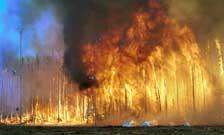Scientists study El Nino fires in Indonesia

Scientists at King's College London have received funding from the Natural Environment Research Council (NERC) to use drones to measure how Indonesian wildfires made worse by El Niño affect the atmosphere.
The six-month urgency grant, usually only awarded to allow scientists to respond rapidly to unexpected and transient events affecting the environment, will allow the researchers to assess carbon and greenhouse gas emissions from fires in the region of the Berbak National Park, Sumatra.
'We know these extreme fires have a major impact on the Earth's atmosphere, and that this is one of the most important ways in which El Niño affects the climate,' says Professor Martin Wooster of the Geography department at King's and Divisional Director of NERC's National Centre for Observation, who will lead the project. 'But we need to find out more about how much material is being burned, and also what is being released into the air, and studying fires in this Indonesian region gives us a unique opportunity to do this.'
Farmers in Indonesia traditionally burn areas of vegetation to help manage the land, but over decades corporations and government-supported initiatives have greatly magnified this activity, clearing huge areas of forest and draining peatlands for agriculture. This makes the affected areas dry out much more quickly. This then allows fires to get out of control and, when they are burning on carbon-rich peat, the soil itself can ignite and burn down into the ground.
Wildfires in such degraded lands are common in the region, sending large amounts of greenhouse gases into the atmosphere. But the current El Niño Southern Oscillation (ENSO) - one of the strongest since 1950, according to the Met Office - has caused droughts in parts of south-east Asia, making the situation far worse than usual. Areas of forest, particularly on peat, that are normally too wet to burn have turned into tinderboxes, leading to extremely widespread and severe fire activities. The fires threaten many ecologically important areas, including habitats for rare species like tigers and orang-utans, and the smoke they give off is a serious threat to local people's health.
During the last strong El Niño in 1997-1998, wildfires raged across tens of thousands of square kilometres of land across Sumatra and Borneo, releasing carbon equivalent to an estimated 13-40 per cent of that year's total worldwide carbon emissions from burning fossil fuels.
Professor Wooster, Dr Tom Smith and PhD Student Jake Simpson will use drones equipped with LIDAR sensors, which use lasers to scan the land surface below. Working with Dr Mandar Trivedi who helped set up the project within one of the areas that the Zoological Society of London (ZSL) are working on in Sumatra, this will provide unprecedented insights into how far down into the peat soil the fires reach. Combined with other data from ground sampling, and also atmospheric measurements, the scientists expect to shed far more light on how much organic matter is being burned, what is being emitted and what the consequences will be.
The fieldwork will improve our understanding of emissions from fires in the region, as well as providing data to scientists who are looking at links between fire, increases in atmospheric CO₂ concentration and El Niño, which should ultimately help improve climate models. It will also contribute to initiatives like the United Nations Collaborative Reducing Emissions from Deforestation & Forest Degradation (REDD+) programme. This aims to give countries financial incentives to preserve their forests and the carbon and biodiversity they contain, and depends on accurate information about forest carbon stocks and GHG emissions levels. Many hope that REDD+ will help protect unique habitats such as Berbak National Park, where the Zoological Society of London are working with Indonesian partners to develop conservation initiatives based around REDD+.
The fires burning across the Indonesian landscape aren't only a problem because of their effects on the climate; the smoke they give off does serious harm to the health of people all over the region, causing potentially life-threatening respiratory problems.
Provided by King's College London





















